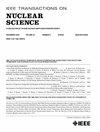Scintillator-Based SiPM Detector: Improved Performance by Equalization of Pulse Arrival Times
IF 1.9
3区 工程技术
Q3 ENGINEERING, ELECTRICAL & ELECTRONIC
引用次数: 0
Abstract
A desired temporal accuracy of scintillator-based detectors is less than 100 ps. In medical imaging, this is necessary for successful time-of-flight positron emission tomography (TOF-PET) measurements. In high-energy physics, the calorimeter time resolution must also be on the order of tens of picoseconds. In this work, we describe a way to achieve such a high level of performance for a detector consisting of a monolithic scintillator that distributes light over several cells of an analog silicon photomultiplier (SiPM) array. Each of the cells is read and analyzed separately, applying a waveform sampling (WFS) technique combined with a nonlinear rise approximation (nLRA). Initially, due to a specific spatiotemporal distribution of photons in the scintillator, as well as saturation and recovery effects inherent to SiPMs, the spread of arrival times deduced from signals of different cells can exceed 1 ns for the same array and the same event. To improve the timing performance, we propose a method of equalization of arrival times for predominantly illuminated cells in the same SiPM array. This results in a coincidence time resolution (CTR) below 100 ps full width at half maximum (FWHM) for a pair of identical detectors.基于闪烁体的SiPM探测器:通过均衡脉冲到达时间来提高性能
基于闪烁体的探测器所需的时间精度小于100ps。在医学成像中,这对于成功的飞行时间正电子发射断层扫描(TOF-PET)测量是必要的。在高能物理中,量热计的时间分辨率也必须达到几十皮秒的量级。在这项工作中,我们描述了一种实现如此高水平性能的探测器的方法,该探测器由一个单片闪烁体组成,该闪烁体将光分布在模拟硅光电倍增管(SiPM)阵列的几个单元上。每个细胞分别读取和分析,应用波形采样(WFS)技术与非线性上升近似(nLRA)相结合。最初,由于闪烁体中光子的特定时空分布,以及SiPMs固有的饱和和恢复效应,从不同细胞的信号推断出的到达时间的传播可以超过1 ns对于相同的阵列和相同的事件。为了提高定时性能,我们提出了一种在同一SiPM阵列中对主要照明单元的到达时间进行均衡的方法。这导致一对相同的探测器的符合时间分辨率(CTR)低于100 ps全宽半最大(FWHM)。
本文章由计算机程序翻译,如有差异,请以英文原文为准。
求助全文
约1分钟内获得全文
求助全文
来源期刊

IEEE Transactions on Nuclear Science
工程技术-工程:电子与电气
CiteScore
3.70
自引率
27.80%
发文量
314
审稿时长
6.2 months
期刊介绍:
The IEEE Transactions on Nuclear Science is a publication of the IEEE Nuclear and Plasma Sciences Society. It is viewed as the primary source of technical information in many of the areas it covers. As judged by JCR impact factor, TNS consistently ranks in the top five journals in the category of Nuclear Science & Technology. It has one of the higher immediacy indices, indicating that the information it publishes is viewed as timely, and has a relatively long citation half-life, indicating that the published information also is viewed as valuable for a number of years.
The IEEE Transactions on Nuclear Science is published bimonthly. Its scope includes all aspects of the theory and application of nuclear science and engineering. It focuses on instrumentation for the detection and measurement of ionizing radiation; particle accelerators and their controls; nuclear medicine and its application; effects of radiation on materials, components, and systems; reactor instrumentation and controls; and measurement of radiation in space.
 求助内容:
求助内容: 应助结果提醒方式:
应助结果提醒方式:


